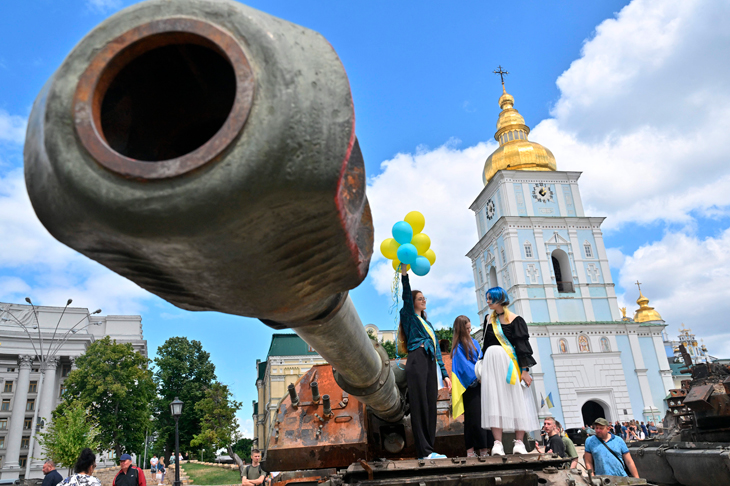With every war, a classic debate is renewed: is superior technology a decisive factor for victory and to what degree? In the case of Russia’s full-scale invasion of Ukraine, now in its third month, it’s a particularly poignant question.
For me, it was partly answered in a windowless, concreted Ukrainian cyber bunker in eastern Ukraine two weeks ago. I watched on a gamer’s screen as a drone destroyed a Russian BTR 80, a much-lauded armoured personnel carrier which may have cost up to $1 million AUD. The soldier, a former IT professional, who flew the drone and accomplished the mission also built it from parts one can buy on the Internet. It can move at 120kph, dodge electronic signal blocking, fly up up to 4 kilometres away, and costs around $500.
Let’s first step back. On the one hand, there is the Russian Federation, once considered the ‘second strongest military in the world’, and its emphasis in doctrine and practice to big pieces of technology, be they landborne or airborne. Whether under Putin or in Soviet or Tsarist times, Russia has historically utilised military technology to at least project, if not assert, its power.
On the other hand, there is Ukraine which de facto had minimal military personnel or major armaments to 2014, when Donbas and Crimea were forcibly occupied by Russia, but has been in a rapid development process. However, that development was constrained by frail economics, on-going hybrid war by its foe, and limited access to Western IP / support. The Ukrainian Security and Cooperation Centre, a policy and programs NGO working closely with the Armed Forces of Ukraine, has long participated in related developments. I saw the bunker when I joined one of their field visits to eastern Ukraine. Their chairman, Serhii Kuzan, said: ‘Fighting against a bigger and better armed foe was made possible by two aspects for Ukraine. First, there is a new generation of commanders of the Armed Forces who are both loyal to independent Ukraine and experienced from successfully battling Russia in Donbas. Secondly, there was a major reform of the Armed Forces in 2019, which was aimed at ensuring we can beat the Russians through mobility, autonomy in decision making, and technological excellence.’
Those aspects reflect Ukrainians’ own anti-authoritarian and tech-savvy traits. Even in wartime, Ukraine has better connectivity, better mobile phone carrier services, and (arguably) a more dynamic IT sector than Australia. One draws strange looks, for example, when one asks for a printed menu, rather than a QR code, in cafes here.
The military innovations are rife. The use of self-produced ‘kamikaze drones’ is one example, but part of a larger capability. The bunker recounted visually and digitally tracks the positions of all Russian military pieces within a range of hundreds of square kilometers. A young intelligence officer (with seven years of combat experience) pointed to an outer ring of artillery pieces on a screen and told me that ‘they are waiting on a visit from Mr Howitzer’. The officer has what many of his Western peers would envy; electronic intelligence drawn from drones, satellites and human intelligence drawn from operatives, recon. units and an innovative national hotline. The Ukrainians also transform digital capability into battlefield advantage via the use of an app to direct artillery fire. Rather than rely on conventional chains of command to select targets and direct fire, Ukrainian artillery units can opportunistically ‘claim’ targets of convenience from those listed on their bespoke app. Uber meets salvos of steel. It’s the crowdsourcing of combat capability. By contrast, their Russian opponents have until recently relied on artillery support that is slow and geographically limited. Doesn’t all this have the risk of somebody just unplugging the internet? Enter a certain eccentric billionaire. Thanks to Elon Musk some 40 low-orbit SpaceX satellites beam high-speed, easy-access internet to Ukraine, including through some 11,000 plug-and-play, pizza box-sized Starlink reception stations, some powered by car batteries.
A senior leader of a voluntary defence unit, based then in Kyiv’s outskirts, recounted their special operation to place some 40 stations that enabled continuous, fully encrypted communications and visuals during a critical stage of the battle for the Ukrainian capital. Thereafter, there was a direct correlation in the destruction of Russian battlefield units, which now stands at some 1,000 neutralised tanks, and personnel, which now stands at some 31,000 killed in action. In the successful defence of Kyiv and Kharkiv, Ukraine’s second-largest city, Starlink and other innovations, coupled with shoulder-mounted weapons such as Javelins, NLAWs and Stingers, let the Ukrainians move deadly fast against a better-armed opponent, but one also struggling with food, fuel and other logistical resupply, and poor discipline. The war has now shifted to the east and south of Ukraine, and to a focus on artillery and other bombardment of Ukrainian civilian infrastructure followed by small-scale infantry advances. The technological dimension of the war has changed with it.
Perhaps from desperation, the Russians, who have lost some 20 generals in battle, have switched to pressing their own technological advantage: deployment of more artillery and missile launch systems, the greater range of those systems, and more currently available ammo. They nevertheless will hit some more operational walls, as well as their on-going problems with effective command and morale. For example, a Ukrainian officer told me that it typically takes three years of production to resupply the artillery shells that the Russians have fired in three months.
For their part, while still highly motivated, Ukrainian officers now openly speak of low stores of older Soviet artillery ammo. Even as they wait for the critical mass of Western military aid to arrive, they point out the numerical imbalances that will be ongoing and their need for even more longer-range howitzers and missile systems. They say it’s simple: that they are determined to take the fight to the enemy but must have adequate cover to do it.
For Putin, it’s now as much about using his artillery advantage to inflict psychological terror and mass exodus on Ukrainians. He simultaneously waits for the West to grow war weary or annoyed with the higher prices and food shortages that he initiated.
Indeed, having stated that he acts as Tsar Peter did, and now collecting record oil revenue, Putin counts on a political backdown that delivers him an imperial vision of a ‘New Russia’ based on Ukraine’s Donetsk, Luhansk and Kherson provinces. A compromise that not only costs millions of Ukrainian lives but effectively let’s him achieve global leverage and imperial destiny through murder. War is about constant calibration. Whether it’s in the sights of an individual soldier’s weapon or in the command centres of global leaders. The outcome in the next few months in Ukraine will be very much about who can recalibrate the most quickly and effectively, including technolgically. Kuzan believes the next few months are critical and a key test for Western democracies to deliver more, effective firepower more quickly. The Ukrainians have shown themselves incredibly adept over the last three months. Whether Western leaders, including our new Labor government, will be equally adept going forward is another matter.
Got something to add? Join the discussion and comment below.
Get 10 issues for just $10
Subscribe to The Spectator Australia today for the next 10 magazine issues, plus full online access, for just $10.
You might disagree with half of it, but you’ll enjoy reading all of it. Try your first month for free, then just $2 a week for the remainder of your first year.














Comments
Don't miss out
Join the conversation with other Spectator Australia readers. Subscribe to leave a comment.
SUBSCRIBEAlready a subscriber? Log in